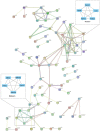Gene Cascade Shift and Pathway Enrichment in Rat Kidney Induced by Acarbose Through Comparative Analysis
- PMID: 34095098
- PMCID: PMC8176958
- DOI: 10.3389/fbioe.2021.659700
Gene Cascade Shift and Pathway Enrichment in Rat Kidney Induced by Acarbose Through Comparative Analysis
Abstract
Acarbose is an effective anti-diabetic drug to treat type 2 diabetes mellitus (T2DM), a chronic degenerative metabolic disease caused by insulin resistance. The beneficial effects of acarbose on blood sugar control in T2DM patients have been confirmed by many studies. However, the effect of acarbose on patient kidney has yet to be fully elucidated. In this study, we report in detail the gene expression cascade shift, pathway and module enrichment, and interrelation network in acarbose-treated Rattus norvegicus kidneys based on the in-depth analysis of the GSE59913 microarray dataset. The significantly differentially expressed genes (DEGs) in the kidneys of acarbose-treated rats were initially screened out by comparative analysis. The enriched pathways for Gene Ontology (GO) and Kyoto Encyclopedia of Genes and Genomes (KEGG) analyses were further identified. The protein-protein interaction (PPI) analysis for DEGs was achieved through the STRING database mining. Pathway interrelation and hub genes for enriched pathways were further examined to uncover key biological effects of acarbose. Results revealed 44 significantly up-regulated genes and 86 significantly down-regulated genes (130 significant differential genes in total) in acarbose-treated rat kidneys. Lipid metabolism pathways were considerably improved by acarbose, and the physical conditions in chronic kidney disease (CKD) patients were improved possibly through the increase of the level of high-density lipoprotein (HDL) by lecithin-cholesterol acyl-transferase (LCAT). These findings suggested that acarbose may serve as an ideal drug for CKD patients, since it not only protects the kidney, but also may relieve the complications caused by CKD.
Keywords: Rattus norvegicus; acarbose; comparative analysis; kidney; lipid metabolism.
Copyright © 2021 Weng, Zhu, Dai, Mi, Wang, Liu and Zheng.
Conflict of interest statement
The authors declare that the research was conducted in the absence of any commercial or financial relationships that could be construed as a potential conflict of interest.
Figures



Similar articles
-
The identification of key genes and pathways in hepatocellular carcinoma by bioinformatics analysis of high-throughput data.Med Oncol. 2017 Jun;34(6):101. doi: 10.1007/s12032-017-0963-9. Epub 2017 Apr 21. Med Oncol. 2017. PMID: 28432618 Free PMC article.
-
Identification of key pathways and genes in colorectal cancer using bioinformatics analysis.Med Oncol. 2016 Oct;33(10):111. doi: 10.1007/s12032-016-0829-6. Epub 2016 Aug 31. Med Oncol. 2016. PMID: 27581154
-
Differentially expressed genes induced by β-caryophyllene in a rat model of cerebral ischemia-reperfusion injury.Life Sci. 2021 May 15;273:119293. doi: 10.1016/j.lfs.2021.119293. Epub 2021 Mar 8. Life Sci. 2021. PMID: 33705733
-
Molecular mechanism of estrogen-mediated neuroprotection in the relief of brain ischemic injury.BMC Genet. 2018 Jul 20;19(1):46. doi: 10.1186/s12863-018-0630-y. BMC Genet. 2018. PMID: 30029590 Free PMC article.
-
Microarray based analysis of gene expression patterns in pancreatic neuroendocrine tumors.Eur Rev Med Pharmacol Sci. 2015 Sep;19(18):3367-74. Eur Rev Med Pharmacol Sci. 2015. PMID: 26439030
Cited by
-
Reveal the Mechanisms of Yi-Fei-Jian-Pi-Tang on Covid-19 through Network Pharmacology Approach.Comput Intell Neurosci. 2022 Jul 16;2022:1493137. doi: 10.1155/2022/1493137. eCollection 2022. Comput Intell Neurosci. 2022. PMID: 35855804 Free PMC article.
References
LinkOut - more resources
Full Text Sources
Miscellaneous

